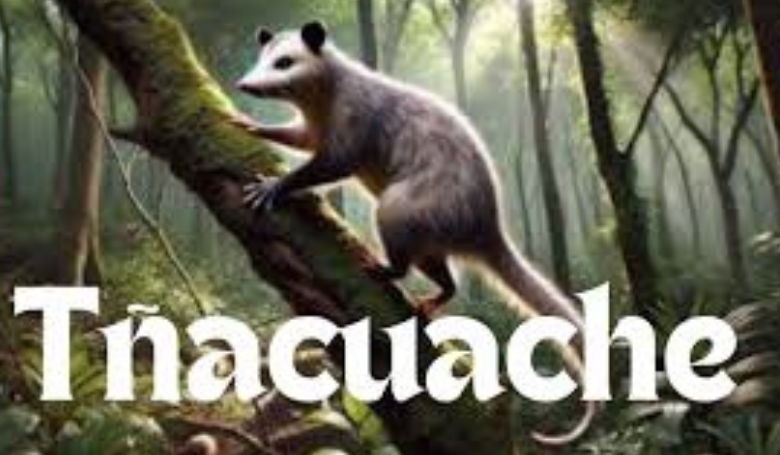Tñacuache: The Night Wanderer of the Animal Kingdom

- Introduction to the Tñacuache
- What is a Tñacuache?
- Cultural and ecological significance
- Physical Characteristics of the Tñacuache
- Size and appearance
- Adaptability to different environments
- Habitat and Range
- Natural habitats of the tñacuache
- Distribution across regions
- Behavioral Traits
- Nocturnal behavior
- Diet and feeding habits
- How tñacuaches interact with their environment
- The Role of the Tñacuache in Ecosystems
- Contribution to the balance of ecosystems
- Impact on local wildlife
- The Tñacuache in Folklore and Mythology
- The tñacuache in Indigenous legends
- Symbolism in various cultures
- Tñacuache’s Survival Tactics
- Playing dead: The famous defense mechanism
- Climbing and hiding strategies
- The Tñacuache’s Reproductive Cycle
- Mating season
- How they raise their young
- Common Predators and Threats
- Natural predators of the tñacuache
- Human-related threats
- Human-Tñacuache Interaction
- How humans view the tñacuache
- Coexistence with humans in urban areas
- The Importance of the Tñacuache to Indigenous Communities
- Traditional uses of the tñacuache in Indigenous societies
- The tñacuache as a symbol of resilience
- Conservation Efforts for the Tñacuache
- Protecting their habitats
- Why conserving tñacuaches matters for biodiversity
- Common Misconceptions about the Tñacuache
- Debunking myths about the tñacuache
- The truth behind its misunderstood reputation
- How to Spot a Tñacuache
- Tips for identifying tñacuaches in the wild
- Where and when you are most likely to see them
- Conclusion
- The enduring significance of the tñacuache
- Why we should appreciate the tñacuache’s role in nature
- FAQs
- What does the tñacuache eat?
- Are tñacuaches dangerous to humans?
- How long do tñacuaches live?
- Why do tñacuaches play dead?
- Where can I see a tñacuache in the wild?
Tñacuache: The Night Wanderer of the Animal Kingdom
The tñacuache, commonly known as the opossum, is a fascinating creature that roams the night, balancing between myth and reality. Many people have heard stories or even seen this nocturnal mammal, yet few truly understand its significance in the ecosystems it inhabits. From its unique defense mechanism to its role in cultural folklore, the tñacuache has much to offer.
What is a Tñacuache?
The tñacuache is a marsupial, a type of mammal that carries and nurtures its young in a pouch. It is often referred to as the “opossum” in English-speaking regions. These creatures are more than just urban scavengers—they are integral to the environments they inhabit and have been deeply ingrained in the cultural lore of many communities.
Cultural and Ecological Significance
In various cultures, especially in Latin America, the tñacuache holds symbolic meanings, often representing survival and adaptability. Ecologically, they serve an essential role by controlling insect populations and scavenging carrion, helping to keep ecosystems in balance.
Physical Characteristics of the Tñacuache
Tñacuaches are medium-sized mammals, with gray or white fur, sharp teeth, and a long, hairless tail. Their size varies depending on the region they inhabit, but they typically weigh between 4 to 14 pounds and measure up to 40 inches in length, including the tail. One of their most notable physical traits is their prehensile tail, which they use for climbing and balance.
Adaptability to Different Environments
The tñacuache is an adaptable creature, capable of thriving in a range of environments from dense forests to urban areas. This adaptability is a testament to their evolutionary success, allowing them to survive in diverse habitats.
Habitat and Range
Natural Habitats of the Tñacuache
Tñacuaches are primarily found in the Americas, with species native to both North and South America. They inhabit woodlands, marshes, and grasslands but are also commonly found in suburban and urban areas, where they scavenge for food.
Distribution Across Regions
Their range extends from southern Canada through the United States, down into Central America, and parts of South America. The adaptability of the tñacuache allows it to thrive in both tropical and temperate climates.
Behavioral Traits
Nocturnal Behavior
Tñacuaches are nocturnal animals, meaning they are most active during the night. They typically spend their nights foraging for food, and their keen sense of smell helps them locate meals in the dark.
Diet and Feeding Habits
As omnivores, tñacuaches have a diverse diet. They consume fruits, insects, small mammals, and even human food waste. Their ability to eat a wide range of food sources helps them survive in various environments.
Interaction with the Environment
Tñacuaches contribute to the health of ecosystems by acting as natural pest controllers. By eating insects and small animals, they help regulate these populations, maintaining balance in the environment.
The Role of the Tñacuache in Ecosystems
Tñacuaches play a critical role in ecosystems by serving as both predators and scavengers. Their diet helps control pest populations, while their scavenging cleans up organic waste, preventing the spread of disease.
Impact on Local Wildlife
By keeping insect and rodent populations in check, tñacuaches indirectly support the survival of other wildlife species, creating a more balanced and healthy ecosystem.
The Tñacuache in Folklore and Mythology
In many Indigenous cultures, the tñacuache is seen as a symbol of cunning and resilience. Legends often depict the tñacuache as a trickster figure, capable of outsmarting stronger predators. These stories have helped preserve the cultural significance of the tñacuache through generations.
Symbolism in Various Cultures
Beyond folklore, the tñacuache is often seen as a representation of adaptability and survival, qualities that many cultures value. In some regions, it is believed that the tñacuache has special abilities to bring good luck or protect homes from pests.
Tñacuache’s Survival Tactics
Playing Dead: The Famous Defense Mechanism
Perhaps the tñacuache’s most famous survival strategy is “playing dead.” When threatened, it collapses into a state that mimics death, fooling predators into losing interest. This tactic, called “thanatosis,” can last for several minutes, giving the tñacuache enough time to escape once the predator leaves.
Climbing and Hiding Strategies
In addition to playing dead, tñacuaches are excellent climbers. Their prehensile tail and strong limbs help them navigate trees and other structures with ease, allowing them to hide from predators and find food in hard-to-reach places.
The Tñacuache’s Reproductive Cycle
Tñacuaches have a short breeding season, with females typically giving birth to large litters of up to 20 offspring. However, not all of the young survive, as only those who make it to the mother’s pouch continue to develop.
Raising Their Young
Tñacuache mothers are protective and carry their babies in their pouch for up to two months. After that, the young will cling to their mother’s back as she moves around, learning how to survive in their environment.
Common Predators and Threats
Natural Predators of the Tñacuache
Tñacuaches face threats from a variety of predators, including owls, foxes, and coyotes. Despite their many survival tactics, they often fall prey to these larger animals.
Human-Related Threats
Unfortunately, tñacuaches also face dangers from human activity, including habitat destruction, road traffic, and hunting. Their adaptability to urban environments sometimes puts them at odds with humans, who may see them as pests.
Human-Tñacuache Interaction
How Humans View the Tñacuache
In some areas, the tñacuache is seen as a nuisance due to its scavenging behavior, while in others, it is respected for its role in controlling pests. Education about the tñacuache’s ecological role could help shift public perception in its favor.
Coexistence with Humans in Urban Areas
As urban sprawl continues, tñacuaches have adapted to living alongside humans. While this can lead to conflicts, there are ways to peacefully coexist, such as securing trash bins and creating natural habitats that encourage tñacuaches to stay away from human dwellings.
The Importance of the Tñacuache to Indigenous Communities
Traditional Uses of the Tñacuache
There are many misconceptions about tñacuaches, such as the belief that they are aggressive or dirty animals. In reality, they are shy creatures that pose little threat to humans and play a vital role in the ecosystem.
The Truth Behind Its Misunderstood Reputation
While tñacuaches are often misunderstood, education can help people appreciate their ecological importance and unique behaviors. They are not pests but rather helpful creatures that contribute to the health of their environments.
How to Spot a Tñacuache
Tips for Identifying Tñacuaches in the Wild
Tñacuaches can be identified by their grayish fur, pointed snout, and long, hairless tail. They are most often seen at night, foraging for food or climbing trees.
Where and When You Are Most Likely to See Them
The best time to spot a tñacuache is during the evening or early morning. Look for them near wooded areas or places where they might scavenge for food, such as parks or suburban backyards.
Conclusion
The tñacuache is a resilient and misunderstood creature that plays an important role in maintaining the balance of ecosystems. Whether viewed through the lens of folklore or biology, its contributions to both the environment and culture cannot be ignored. As urbanization continues to expand, understanding and appreciating the tñacuache will be vital to ensuring a future where humans and wildlife coexist harmoniously.
FAQs
What does the tñacuache eat?
Tñacuaches are omnivores, meaning they eat a variety of foods including fruits, insects, small animals, and even human food waste.
Are tñacuaches dangerous to humans?
No, tñacuaches are generally shy and non-aggressive towards humans. They are more likely to play dead than attack.
How long do tñacuaches live?
In the wild, tñacuaches typically live for about 2 to 4 years, though their lifespan can vary depending on environmental factors.
Why do tñacuaches play dead?
Playing dead is a defense mechanism used by tñacuaches to avoid predators. This behavior, known as “thanatosis,” can fool predators into thinking the tñacuache is no longer a threat or edible.
Where can I see a tñacuache in the wild?
Tñacuaches are most commonly found in wooded areas or urban settings, especially at night. They are native to the Americas, so you may see them throughout North and South America.



